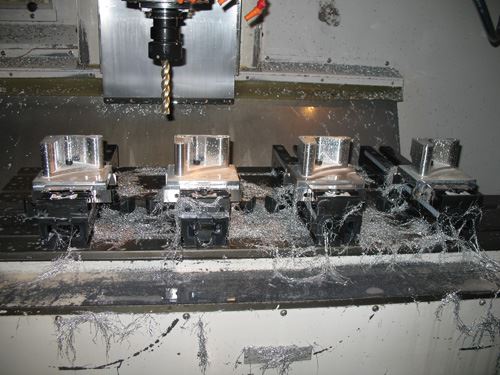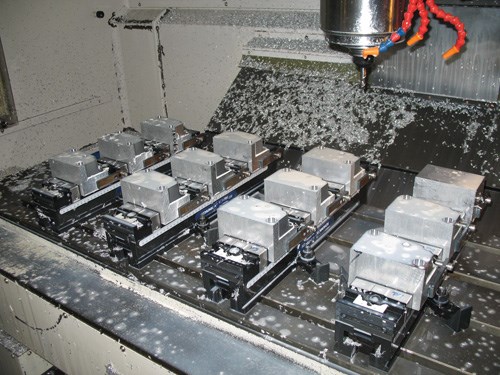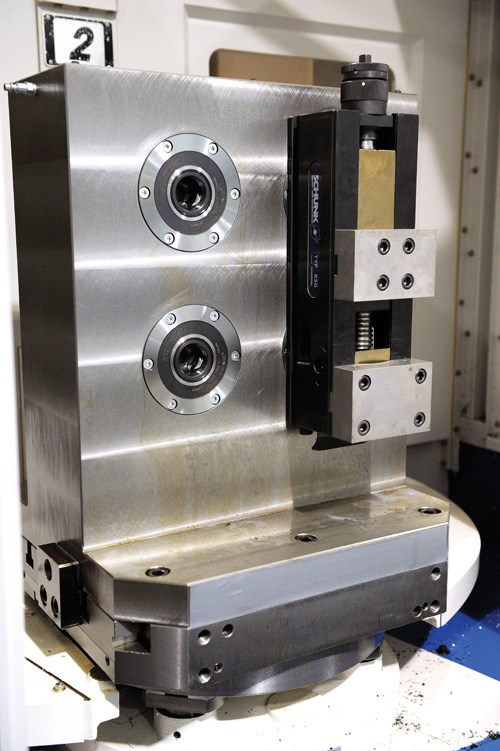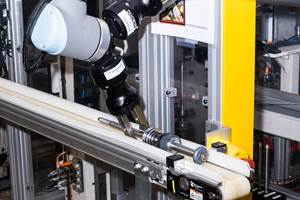Getting Concept To Car Faster
Joe Gibbs Racing applies a number of workholding techniques to speed the production of racing components its engineering team creates every day.
Share





In terms of car development, one might think that a NASCAR race team primarily conceives and manufactures fresh part designs between seasons. That’s not the case. In fact, Joe Gibbs Racing (JGR) created some 1,200 new race car components at its Huntersville, North Carolina headquarters throughout all of 2008. Its substantial engineering department generates different designs each day as part of its efforts to continually improve car performance in a highly competitive racing environment. This puts pressure on JGR’s in-house machine shop to manufacture those components as quickly as possible so that the team’s drivers can immediately reap the benefits on the track. So in a sense, JGR’s manufacturing department is a job shop charged with creating small batches of various workpieces in short order.
To that end, JGR’s shop strives to reduce and simplify setups, just as all job shops do. JGR benefits because Schunk, which is located in nearby Morrisville, is its official workholding solutions provider. The shop uses a variety of Schunk workholding devices on its 18 Doosan HMCs, VMCs and turning centers (Doosan is a JGR technical sponsor).
For example, the first Schunk workholding device the shop used was a Magnos electropermanent magnetic chuck. Setups for a particular mounting plate were time-consuming because shimming was required to level the plate on the VMC prior to machining. Self-leveling pole extensions on the magnetic chuck eliminated the need for shimming, enabling both faster setups and improved tolerances. The magnetic chuck is also helpful in securing tubular components such as track bar sliders for machining. A track bar slider is a 2-inch-diameter tube that requires flats on opposite sides that must be milled parallel to each other. Using the magnetic chuck, the shop has been able to achieve parallelism of 0.0005 inch for those flats without distorting the tube.
JGR’s shop also benefits by using Schunk’s Unilock quick-change pallet system. The photo on page 94 shows the system integrated into a tombstone used on one of the shop’s Doosan HMCs. The Unilock pallet modules on the tombstone provide a common mounting interface that accepts pins used on vises or fixture plates. The system is pneumatically released and spring actuated, and provides both quick installation of workholding devices and accurate positioning.
While the machine is running one job, parts for the next can be set up on the appropriate workholding device. The pallet system allows operators to quickly remove the fixture holding the completed parts and install the fixture with workpieces for the next job. The common mounting pin interface allows the shop to use any of its existing fixturing or vises with the pallet system. This system also allows JGR to interrupt a part run with a more urgent part without lengthy set up changes.
The Kontec KSM Rail multiple-part mechanical clamping system is another workholding device JGR uses on its machining centers. This system allows the shop to clamp numerous workpieces on a machine table for long stretches of unattended machining and improved throughput. It consists of a fixed jaw and one or more moving jaws on a clamping rail that adjust to secure parts of different sizes. The shop often uses multiple clamping rails on a machine’s table to maximize the number of parts machined in one setup.
The photos below show such applications. Alternator brackets like the ones shown were previously secured using two single-station vises on the table at a time. Using the Kontec system, the shop now sets up 12 parts per load for first operation and four parts per load for the second. This reduces tool changes and door openings, saving a total of 2 hours and 15 minutes for a batch of 50 parts. This also frees 7 hours for the operator to tend to other machines.
Machine operators in JGR’s shop are akin to members of the team’s pit crew. They must be able to quickly, yet precisely set up new jobs to minimize machine down time. The various workholding strategies that make this possible are key reasons why JGR can bring an engineer’s concept to a race car faster.
Related Content
JIMTOF 2024 Report: EVs, AI and Autonomous Robots Abound
The 2024 Japan International Machine Tool Fair (JIMTOF) showed how the manufacturing industry is adapting to the needs of electric vehicle manufacturing and adopting new technology including AI and autonomous robots.
Read MoreEliminating Automotive Defects Per Million With Automated Visual Inspection
This automotive manufacturer virtually eliminated PPM defect complaints after implementing an automated visual inspection system at its facility.
Read MoreArch Cutting Tools Acquires Custom Carbide Cutter Inc.
The acquisition adds Custom Carbide Cutter’s experience with specialty carbide micro tools and high-performance burrs to Arch Cutting Tool’s portfolio.
Read MoreThe Role of Surface Finishing in Modern Manufacturing: Trends and Best Practices
You’re attending IMTS to advance your business. Regardless of your role in the manufacturing process, considering how your parts will be finished is crucial. This article can help you understand trends in surface finishing and better communicate with your finishing partners.
Read MoreRead Next
Setting Up the Building Blocks for a Digital Factory
Woodward Inc. spent over a year developing an API to connect machines to its digital factory. Caron Engineering’s MiConnect has cut most of this process while also granting the shop greater access to machine information.
Read MoreBuilding Out a Foundation for Student Machinists
Autodesk and Haas have teamed up to produce an introductory course for students that covers the basics of CAD, CAM and CNC while providing them with a portfolio part.
Read More5 Rules of Thumb for Buying CNC Machine Tools
Use these tips to carefully plan your machine tool purchases and to avoid regretting your decision later.
Read More


























.jpg;maxWidth=300;quality=90)











